Our Vacation in India
Delhi
We woke up at 8:30 in the morning, after eight hours of sleep at the hotel, plus two more on the train the night before for Marcus and me. Robert had been up and down all night with his stomach, and he finally broke down and took the antibiotic the doctor had prescribed for us before we left (as a “just in case” sort of thing. “When should I take it?” Robert had asked. “You’ll know,” the doctor said).
Marcus was super happy and energized, though, and I was pretty well rested, and it was a lovely sunny morning, so we went down to a nice breakfast. The cold buffet was included with the room, though we could have ordered uttapam or dosas or idli or Indian scrambled eggs (or even a Japanese breakfast) and paid for them separately if we’d wanted. Instead, for today, since Robert’s stomach was funny and I kept telling him to eat light, we stuck to the buffet—two kinds of lassis, five kinds of juices, cold cuts, breads, pastries, muffins, jams, cheeses, fruit (including mangoes), lovely fluffy yogurts, and cereals. Marcus was happy and loved the mango yogurt. Robert was less happy.
We went back up to the room and Robert flopped down on the bed again. We spent the morning in the room, with Marcus playing around, happily (he particularly liked hiding Lego structures in the numerous built-in cabinets and cubbies in the bathroom and closet area) and Robert lying on the bed nursing his stomach.
At midday he decided—not that he felt better, no, not that—that he could summon up his reserves of stoicism and power on through the discomfort to actually go out for a short trip, as long as it involved air conditioning and access to a bathroom. I rolled my eyes at his “stoicism” speech. He ignored me.
We got a hotel car and driver to go to a nearby mall, figuring that Marcus could run around, Marcus and I could eat some lunch, it would get us out of the hotel a little, and it would be fun to see what an Indian mall was like. On the way there, Robert asked our nice Sikh driver what Sikh men did with motorcycle helmets and their turbans. “Helmet, Sikh, not allowed helmet, other people, yes allowed,” he said, helpfully. This was actually his second attempt at answering this question—the first time Robert had asked, he got an answer about the cost of motorcycles to buy new vs. used.
Communication, after all, had been pretty difficult with waiters and drivers especially. Just the day before, in Agra, Marcus had just woken up from a nap when we went down to lunch in the hotel, and he was sort of fussy and unhappy at being awake. A waiter came over and said, “Would he like an ice cream?” “Oh no, thank you,” I said, wrestling with Marcus on my lap. “He just woke up—he’ll be fine in a few minutes.” Then I caught sight of Robert’s face—concerned, squinting, head-tilted, eyebrow-raised—and I said, “Well, wait, maybe—Robert, what do you think?” He turned to me, then, and I saw that he hadn’t understood a single syllable the waiter had said.
In the car, today, we at least understood the words, but not at all the intent. The driver took us to the mall, which was actually two malls, MDF and City Walk, right across the street from each other. He seemed to indicate that City Walk was better in some way, so we went there, going through the crazy metal detectors at which it seems totally unclear what they’re actually looking for. You beeped? Never mind, go on through. Yes, we have metal somewhere on us. (I hear the elderly keep secret reserves of metal on them. . . )
Marcus had fallen asleep in the car, so I wore him in the mei tai through the first part of the mall. We wandered around and people watched. In the space of an hour here we saw the third, fourth, fifth, and sixth strollers we had in all of India. Overall, we saw so many Western clothes, US brands, and really rich people.
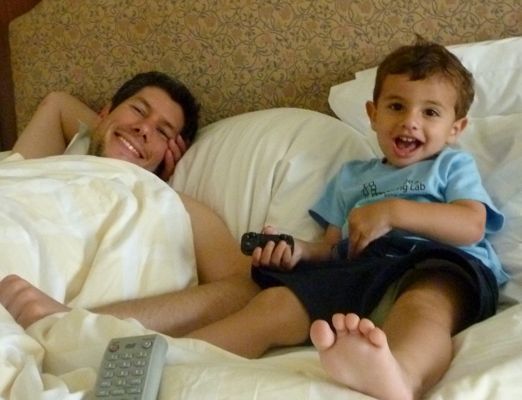 Left: sick daddy, but happy baby.
Left: sick daddy, but happy baby.
Below: buying six varieties of mangoes at an upscale market in a mall
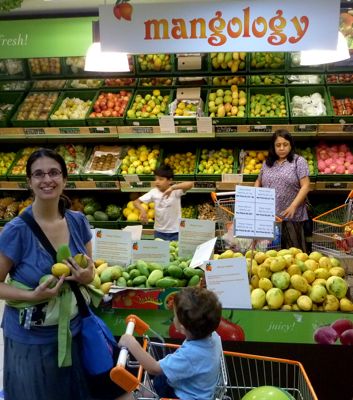
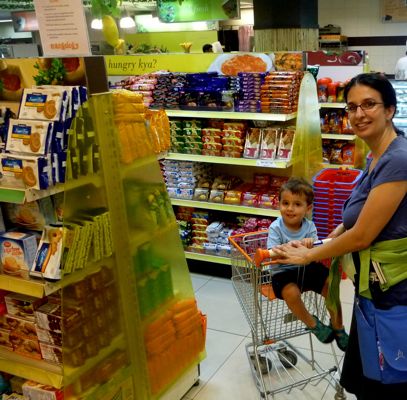
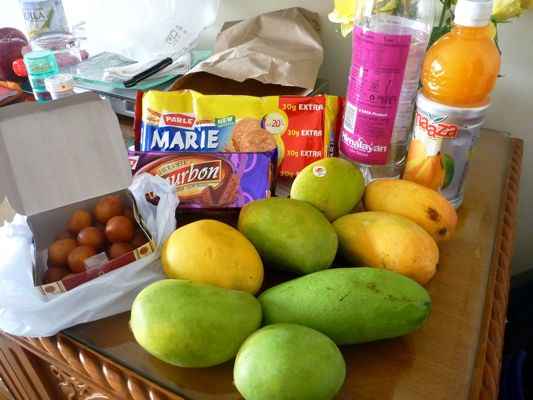
Lunch was a quick sushi box from a stand and a veg combo tray for 185 INR (fast food is pricy food) at the food court, with excellent naan, cauliflower, potatoes, dal, salad, rice, and paneer, plus a lime soda (“Salty, sweet, mix, ma’am?” Uh, yeah, just sweet for me. . . I don’t do those salty drinks. Robert thinks they taste like Gatorade, and I think they’re probably the same idea, really). The food court was full of families with young kids (one sent their six-year-old back to give Marcus his balloon when they saw him ogling it) and college-aged kids—all happy and nicely dressed.
Our next stop was a magazine stand, where we picked up a couple Indian wedding magazines for Asma, and then an actual (if small) supermarket on the ground floor of the mall. We bought some basic English-style cookies (20 rupees for a big package) and then six mangoes, one of each variety they had: an Alphonso (28 rupees), a Dasheri (14), a Kesar (9), a Madras (7), a Totapuri (7), and a Malgoba (6).
Finally we stopped at a donut place. There were actually two different donut stands in the mall, each offering donuts in a bowl or donut sundaes, but we just got six mini donuts, hot, with fudge and caramel poured over them. These donuts were heavenly—super dense, not at all airy. Apparently I’m an Indian-style donut lover. Marcus ate a plain one—he rejects chocolate things and sticky things in his hands—so I scooped his caramel onto mine.
Back in the car, we drove to a sweet shop near the hotel to pick up more gulab jamon. A place in the mall had advertised a gulab jamon sundae, with khulfee and strawberry sauce on top of the sticky treat, but they were out of the key ingredient. Nevertheless, that dessert sounded so delicious that we needed to be getting us some gulab jamon before too long. Between the sweet shop and the hotel, we passed the funny Sunder Nager gate again and tried to explain to our driver what had happened the other night. “Oh, so you are Mrs. Michaud!” he said. Apparently we were famous as the difficult couple with the baby.
Marcus and Robert took an afternoon nap that turned into a good night’s sleep. I stayed up for awhile, took a nice bath, wrote, read, and eventually joined them. It was a quiet day, but worth it to get Robert feeling better.
On Thursday we woke up at 5:30, all of us ready to start the day. Robert looked and said he felt so much better—his color was back to normal, his fever was gone, and he was no longer having chills and sweats like yesterday. He took the second dose of the antibiotic, but definitely felt up for going out sightseeing today. We walked around the pool for twenty minutes or so before breakfast—there was a “new” pool, as well as a perfect 1960s-style pool. Marcus had mango lassi, crackers, and poori at breakfast, and we had the cold buffet plus Robert, with his stomach now feeling better, went a little crazy ordering pancakes, waffles, and poori bhaji from the menu. At 7:45, we were washed and ready to go, back down in the lobby setting forth in an actual metered taxi.
The cab took us to Jantar Mantar in Connaught Place, the first of (and a smaller one than) the observatories built by the Raj who built the one in Jaipur we hadn’t made it to, as well as three others. At the entrance, an old man with a cane came up and started talking to us. The usual—where were we from, were we here to see the observatory, etc. He made a point of saying he was not a guide, unlike them (he gestured with his cane at the other men hanging around the entrance). Anyone can say they’re a guide, he said, but they tend not to really know much about the site. Robert agreed. And then they demand money! The man was very emphatic. If anyone says he’s a guide, he’s a cheat. He—he repeated this—is not a guide. We smiled politely and tried to make our way inside without him, but he tagged along. He explained the first structure, then the next, and so on and so on. He had quite the long spiel, with some actual historical information and some completely inaccurate astronomical facts. His style, too, was interactive and aggressive: “How many days in a year, sister?” he asked me. “Wrong! 365 and a quarter!” he corrected. Uh huh. I was getting a kick out of him, though, and Robert seemed to be too—he walked Robert up to the top of all the ones with stairs and explained when the different structures—built to predict the monsoons, predict the eclipses, tell you the day of the month and year by judging how far you are from the solstice and equinox, etc.—fell into disuse and disrepair and even, due to the surrounding buildings, complete dysfunction. At the end, he said he hoped we felt well informed—he hoped that he had imparted his knowledge to us. We were now better informed than any guide, he said, and we could go give tours to others if we want. “And now, pay as you like,” he said, holding out his hand. Robert was surprised by this turn of events (“He kept saying he wasn’t a guide!” he said later), but gave him a couple hundred rupees anyway, and the man seemed very happy.
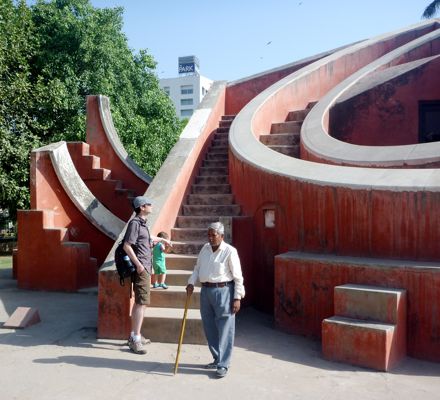
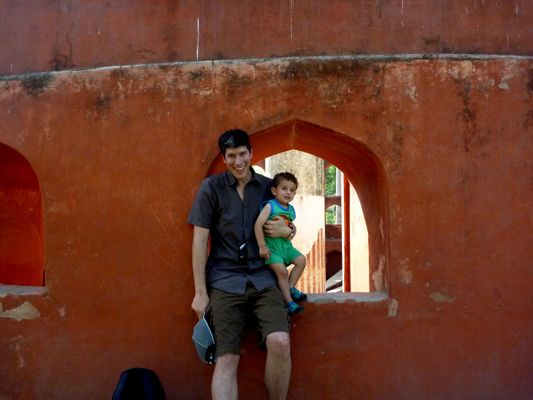
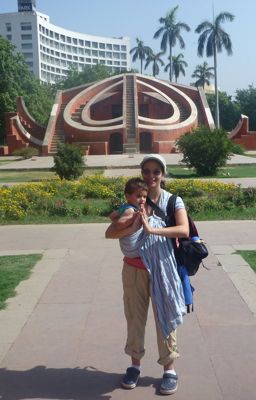
Above: Jantar Mantar, with sundials, calendars, etc.
At the end, he said he’d been doing this—apparently not guiding—for thirty-six years, “Longer, much longer than you live, sister.” “I don’t know about that,” I said mildly. “Not much longer.” He demanded my palm, and scrutinized my lifeline. “Hmmm, see here? You are 25!” he said. “Nope,” I said cheerfully. “Older.” He bent back. “Oh, see, I forgot this part—yes, yes, it’s here. How old?” I told him I was almost thirty-five. “Ah yes! I see, 35!”
Robert was entertained. “Here, do me,” he said, handing him his left palm. “Forty!” the man said relatively promptly. Robert was offended. “No!” “Ah, wait,” the man said, when Robert told him his real age (37, for the record). “See, here? Something is wrong with your lifeline here. Let me see your other hand. Hmmmmm. . . . oh, I see. You have a sickness in your left side. Something is withered there, something is sick and bad, and making your left side look older. Your right side, yes, that’s 37, you are right.” I thought this was creative, to be sure, but worried that Robert might think of the heart condition that plagued his father, grandfather, and grandmother, and get worried. Thankfully, Robert took the man quite so unseriously that he did not.
Still, the man clearly felt that he had delivered some bad news, and did not want to end on such a downer. “Here,” he said to Robert, “you have sisters, brothers? I tell you!” Robert said that he had one sister. “No,” the man said triumphantly. “You are one of four.”
Here Robert felt equipped to argue with him: “No, one of two.”
“Yes, yes, but four total. Two died. Maybe long long ago, you don’t know. Mother never told you, father never told you. You are one of four.”
Robert later said how nice it was the way the man seemed so utterly certain of this. He wished, my mischievous husband said, that he (Robert) had (untruthfully) told the man he was one of eight. “How would he have argued with that, now?” Robert wondered.
From Jantar Mantar, we walked a couple blocks away to a big Sikh temple, where we had heard the tour was very nice and the guides free and very low-pressure. We didn’t know a lot about Sikhism before—other than the New York cabbie connection—but learned more that day. Apparently, being Sikh is a lot like being Christian without Christ: there’s one and only one god/God; you’re supposed to be nice to other people—feed the hungry, help the poor, etc.; you can’t have any graven images or idols; and you are all (not just priests) equal with equal access to God. Oh, and don’t smoke—that’s bad. See, what’s not to like?
 Left and below: at a Sikh temple, covering our heads and touring their soup kitchen
Left and below: at a Sikh temple, covering our heads and touring their soup kitchen
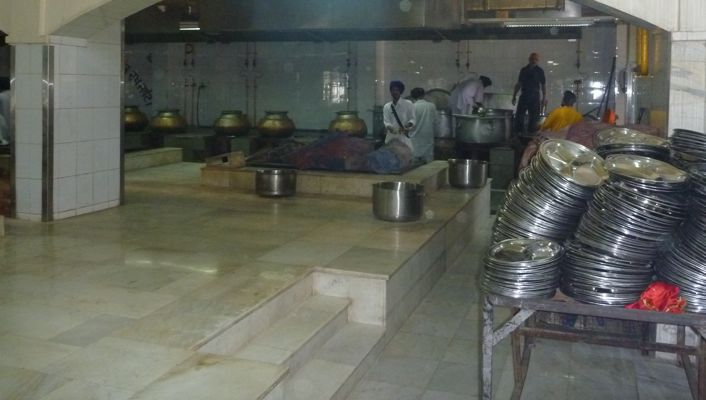
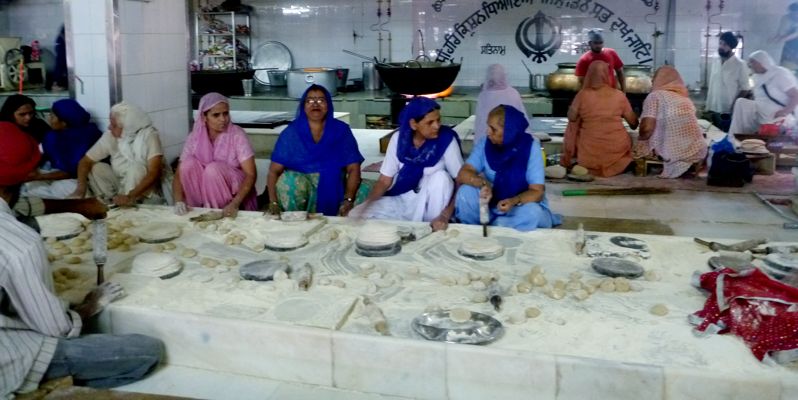
A friendly guide took our shoes (even baby’s, even though he was in a sling), gave us headscarves (not baby), and showed us around the gorgeous white marble complex. We saw the pool for refreshing the soul (“Water cleanses the body and the soul. Anyone can use anytime! Owen Wilson used it!” the guide said) and then the highlight, their newly refurbished soup kitchen where they serve three meals a day to 12,000 people. Now that’s a soup kitchen! We saw their giant, child-sized pots, and the army of women making chapatis for lunch, and everyone smiled at Marcus and waved at him.
Next, we hailed a tuk-tuk to take us to the Red Fort.
Driver: --------? [in Hindi]
Me (getting in): Red Fort?
Driver: No! (motioning me to get out)
Me (getting out): Red Fort?
Driver: RED Fort? Red Fort? Red FORT?
Me: Yes, yes, Red Fort!
Driver (motioning me to get back in): ----------! [in Hindi]
Below: at Red Fort
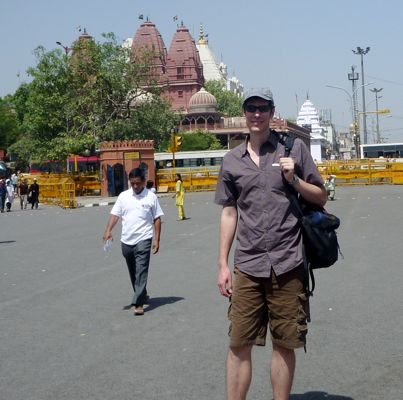

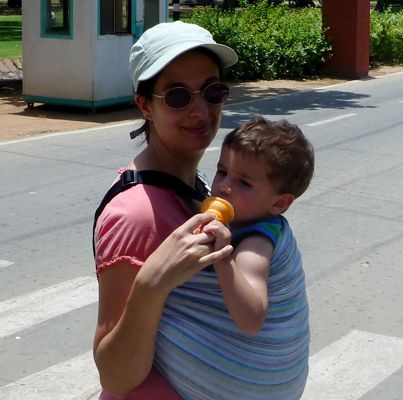
Once at Red Fort—which we knew well, it felt like, because of that nice Indian movie about the blind girl and the tour guide that Asma had told us about a few years ago, the real fun started.
Three families (tourists from other parts of India), plus one pair of young men, stopped and asked to have their pictures taken with us. “Oh look!” We imagined them saying. “A white baby! Wow, you can find anything in Delhi!”
Another family almost had their picture taken with us. The father, with giant camera, pointed at us and said something animatedly to his family (something like, albeit in Hindi, “Wow, look at that white baby! Let’s take a picture of him!”). The teenage son rolled his eyes and grabbed his father’s arm, pulling him away from us (saying something like, “No, Dad, we are so NOT doing that! C’mon, let’s go. . .”).
Three other men (that we saw) took surreptitious cell phone pictures of us, one of them sneaking into the scene himself for his friend, but not talking to us.
There was also some videotaping going on.
We loved that here we were at a tourist site and we were the sight. Robert said we should have asked for a tip. “As you like, as you like!”
We left there warmly, having bought three huge plastic bottles of water, one glass bottle of lemon-lime Mirinda (Robert pronounced it “surprisingly pleasant”), and one ten-rupee rose-flavored soft-serve ice cream cone which Marcus loved and devoured. He has excellent ice cream eating technique. We grabbed a bike rickshaw to take us down the main street of Old Delhi to the spice bazaar, where we got out and walked around. A chorus of sneezes and coughs greeted us, as the peppers really did get caught in your nose and throat (in fact, I felt like I had to sneeze for the next day and a half as a result). Marcus was asleep in the sling, all covered up, which I was glad of—he had loved Jantar Mantar, like a playground with all that climbing, and then gotten a little hot at the Fort, and now was exhausted.
We rode down the narrow lanes, past a sari market, the wedding market, and lots of other bustling areas. Our driver kept calling them “palaces”—“Here is shoe palace, here is sari palace, here is spice palace”—and the linguist in me tried to figure out why. I could see the word “market” or “bazaar,” or even “street,” “area,” “neighborhood,” or “place.” I thought about it being just a mispronunciation of “place,” but could not quite get to the bottom of it. In any case, we were extremely done with the rickety and rollicking bike rickshaw, so we asked to be dropped off at Haldiman’s on the main street, a so-called “family restaurant” and sweet shop.
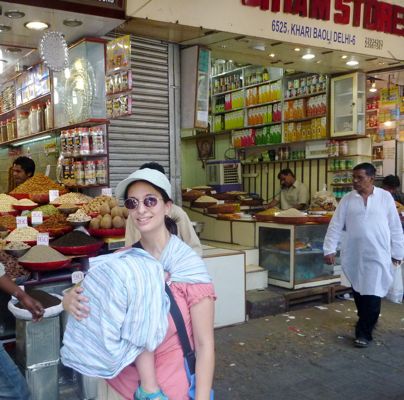
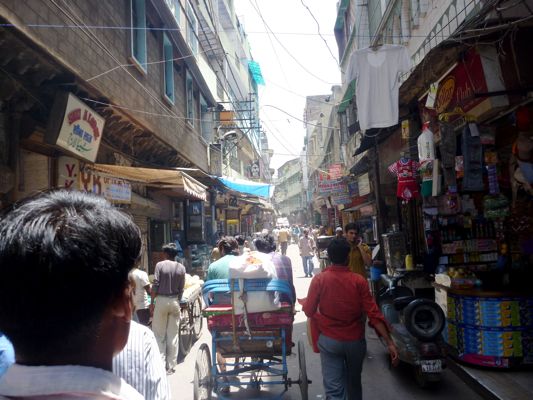
Above: spice market and another Old Delhi street.
The first floor was the sweet shop, and upstairs was a somewhat air-conditioned fast-food-style restaurant. We went a little crazy ordering, and for the equivalent of $6 we got a mango lassi, a bhalla papri chaat, an aloo tikka, a Chinese veg combo (Mongolian veg balls in sauce plus a big bowl of Hakka noodles), a thandi (“milk product drink”) and a parantha. It was all really delicious. Marcus (awake now) tried the lassi and ate a few bites of the potato ball, until it got too spicy for him. Adorably, he just opened his mouth, let the spicy food dribble out, and then wiped off his tongue with his hand, saying “hot! hot!”
There was one other table of Western tourists, but otherwise the place was full of locals, with a bunch of kids and families. On our way out, we got a khulfee stick with pistachios—it was lovely, cool, and super messy since it started disintegrating immediately in the 100-plus-degree weather. We walked along for a few blocks, looking at clothes, and buying a couple Indian-style shirts (locally made, but labeled with “Gap” tags) for Marcus and a friend.
We got an auto rickshaw (thank goodness, no more bikes for us) to go back to the hotel, and got there around 2:45. We had an iced coffee, some mangoes, a nice shower, and a nap in a cool and comfy room, and at 6:30 took a cab to dinner—Bukhara, a famous kebob house in another hotel that was supposed to be one of the best Indian-style restaurants in Delhi. Bill Clinton had eaten there on a trip to India, a few years earlier, and we ordered the Bill Clinton dinner in his honor—essentially one of everything, some lamb and some chicken, dal and rice, tomatoes and cucumbers, naan, and dessert. Despite the hype—mentioned by every guidebook I looked at, my two Indian students last year, and our Agra guide—we went and enjoyed ourselves. It was pricy by Indian (and, actually, American) standards, but we had a ton of food—we brought leftovers back to the hotel with us—and the place was packed, full of businessmen (Indian, Western, and Asian alike) and clearly popular. Marcus loved the onion slices with a spice powder on them, and the chicken leg and wing, and I particularly loved the red dal, which had an earthy flavor I associate more with Mexican-style rice and beans than, typically, Indian dal. I just wasn’t bowled over, though, especially for the price (more than any other meal we ate the whole trip), and the service was kind of annoying—waiters who kept explaining, as though to slow children, that you should eat with your hands and use a finger bowl afterward. Sigh. The kebobs were good, though. . . .
We took a cab back to our hotel, popped the leftovers in the refrigerator, and went to bed at 9:30, then got up happily at 6:00 in the morning. Marcus, who had been particularly charming last night in the restaurant, was also particularly charming this morning. It was our last morning in India, actually, and Robert went all out at breakfast as a result: semolina idli, mango lassi, and delicious mango yogurts—which the chef revealed were about 1/3 whipped cream, plus honey, cooked mango puree, and yogurt too, of course. We ate four bowls that morning.
A radio taxi took us to Lodi Gardens by 8:15, which was perfect because dogs are only allowed in after 8:00 in the morning. We saw a lot of stray dogs, a few British people walking dogs who completely ignored Marcus, and then an older Indian man with long hair and a long beard and two golden labs on leashes. The man talked to us for ten or so minutes, explaining the pro-dog and anti-dog factions in the park; the new restrictions on dogs; the treatment of the strays (he and the other dog people leave food, water, and medicine out for them—and really, they were incredibly tame strays); the rarity of leashes in India; and pretty much anything else we had wanted to know about dog culture in the greater Delhi area. We walked around and went inside three of the fifteenth and sixteenth century tombs, which were impressively just out there, sitting there crumbling and looking monumental in the middle of the park, with people exercising and walking their dogs and doing yoga all around them. Marcus loved the combination of stone things to climb on and dogs to try to pet, and we loved the relative coolness of the morning, coupled with the shade of the inside of the tombs.
Below: Lodi Gardens

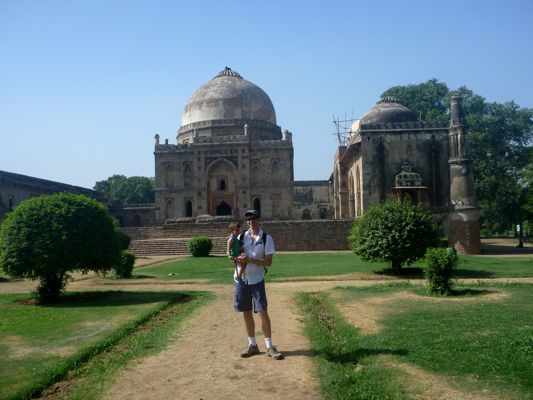

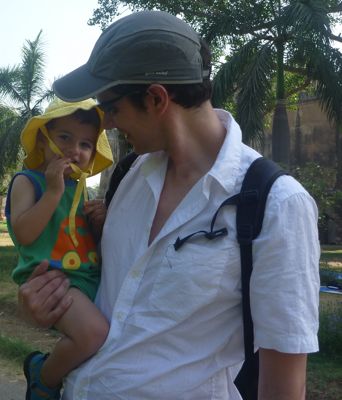
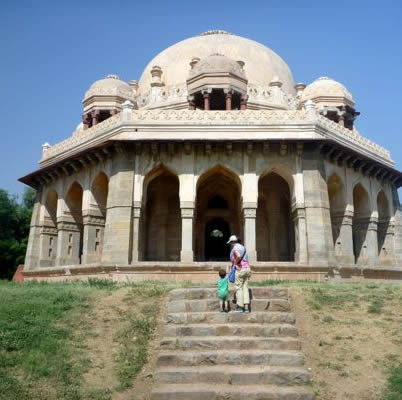
At 10:00 we flagged down a tuk-tuk and took it to the entrance to Hazrat Nizhamuddin, a close-by neighborhood that is extremely Muslim. Walking inside, we felt as though we had suddenly gone to another country—Saudi Arabia, perhaps—with busloads of Muslim men in white robes and head caps arriving to pray at the mosque or study there for the day. The streets were packed and full of people and flies, and we wove in and out of traffic as we tried to find the tomb (aulia) of the Sufi mystic the area is known for. We asked directions a few times, but mostly just kept walking through this neighborhood that felt foreign even for India, to us. Finally, I realized that two woman a little ways ahead of us must also have been looking for the tomb—they kept asking directions, but obviously in a language that they had more success with than our English queries, and they were snaking through the alleys. They were chubby, short, and wore headscarves, and obviously not from this neighborhood, though they fit in better than Robert, Marcus, and I did. When the alleys got covered, and the flower sellers more and more frequent, we realized we were there—we were then asked to leave our shoes before going into the more sacred areas. Robert, wearing shorts, was not allowed to go into the men’s area, the inner part of the shrine, but instead had to stay on the outer ring with me, Marcus, and the other women and children. It was an amazing place, and we were glad we’d braved the somewhat unfriendly people outside to come in and see this. Marcus, in the sling, was not loving the closeness and the flies, though, so we decided to make a quick exit. As we were walking back toward our shoes, the two chubby women I’d been following approached us.
“Hello, you are foreign tourist too?” one asked.
I said yes, we were.
“From what country?” she asked.
Standard script, this—I said we were from the US.
She broke into peals of laughter. “You are from the US? We from Iraq! Hee hee hee hee hee!” she chuckled.
Robert later said that all that flashed into his mind to say, then, was “I’m so sorry. I’m so sorry we bombed your country. We didn’t vote for Bush.”
I was mostly just amused that the two friendliest people in this entire neighborhood were not Indians, but Iraqis. We talked a little more—why did we come here, she wanted to know. She and her friend weren’t impressed with India—they came because the grandfather of their prophet (really?) came here, or came from here, but they have no idea why he would, it’s not a nice place (she said, very cheerfully). Soon her friend, who seemed to speak no English, got antsy and pulled at her arm, and we had to move along.
“I think I stepped on a date in my socks,” Robert said, as we left the area. I laughed. “Me too.”
A few blocks away we hailed a tuk-tuk and had it take us to the nearby tomb of Humayun. At this point, 11:00, we were hot and pretty done with tombs for the day, though, so we asked the driver to wait, and we just walked around the grounds for a few minutes before heading back to the hotel, just another few minutes away.
We went swimming in the lovely new hotel pool, which had two wide sets of steps Marcus loved playing on—he liked stepping down and watching the water level come up, and then jumping off the final step (before he would be completely under) into our arms. Back in the room, we dressed quickly and went up to the top floor to Taipan, the Chinese restaurant in the hotel that we had read was one of the best Chinese restaurants in India. We had their all-you-can-eat dim sum lunch, which at 1950 rupees a person (about $40) was definitely not cheap, but was perfectly greaseless, high-quality, and delicious, presented in a beautiful restaurant with lovely windows and views of Delhi.
The hostess was Indian-born Chinese, and didn’t know a word of either Mandarin or Cantonese, she confessed. We said something about lo bok ko and she said, “Oh! You speak Chinese? I’ll get the chef! But he doesn’t speak any English. . .” and we had to say, no, we were probably better off talking to her. She spoke English with a typical Indian accent, and professed her love of Marcus. We sat at a nice curved booth by the windows, and Marcus curled up on my lap, nursed a little, and fell asleep even before we had ordered. Everything was pork-free except for two dumplings at the very end, and there were of course numerous vegetarian offerings. The chicken-shrimp shumai were my favorite, and we saved a chicken sticky rice packet and a couple other items for Marcus for later. Robert made a pain of himself to the waiter by asking about sauces for the dumplings, and pretty soon we had about a dozen tiny bowls all over our table, as the waiter tried to get Robert the perfect vinegar, perfect chili, perfect ginger. It was all reminiscent of, but quite different than, dim sum in New York/LA/Boston, and we had a great meal and great experience.
Downstairs in the room, Marcus kept napping while I joined him and Robert watched his last batch of Indian TV until 4:00, when we got a hotel car to take us to Dilli Haat, a shopping village with artisans from all over India who travel there for a couple weeks a year. It was about twenty minutes t o the hotel, and we easily spent two hours there and could have walked around even longer as it was getting darker and cooler in the evening.
The guidebooks, one of my students, and one of Robert’s co-workers had all recommended the place, but Robert was leery—he thought it either would be too touristy or else too filthy (memories of the “thumb” incident, I think). Our concierge friend at the hotel, who loved Marcus and kept trying to sneak him in his arms, pronounced it “a lovely place, sir, first class, number one,” and that finally brought Robert around.
There were a couple dozen food stands/outdoor restaurants, a la clam shacks or ice cream stands, and everything was definitely cleaner than the true street food we’d seen in Mumbai. We ate at a Tibetan place that a family with a young girl stopped at and got an order of incredibly rich lamb momos with a couple chicken ones tossed in, possibly by accident, and a (free) tasteless cloudy soup that Marcus loved and kept spooning up. We also got a Coke in a glass bottle, just to have a Coke in India, and were amazed at that classic Coke taste and its evocative powers—all of a sudden, we were not at the end of a long trip eating almost-too-rich mutton dumplings outside in, oh, 110-degree weather with sweat pouring down our faces. Later, our friend the concierge said, “Oh, good choice, sir, you can never go wrong with momos, they are so clean!”
I started feeling mildly unwell while we were there and needed to use the bathroom, which I was apprehensive about, but which actually were pretty clean, smell-free, and completely empty. They were about on par with bathrooms near the public beaches in Hawaii, just with the lack of toilet paper and the addition of Indian-style holes as an alternate to Western toilets. They were completely unlit, as far as I could tell, and I was glad I wasn’t there an hour or so later in the evening.
Below: Dili Haat, for more mangoes and some shopping
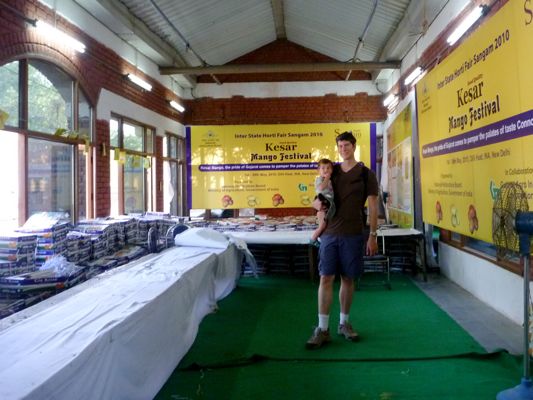
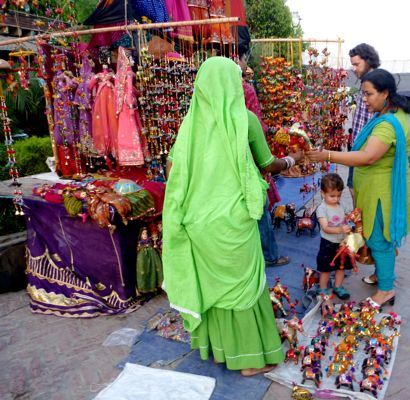
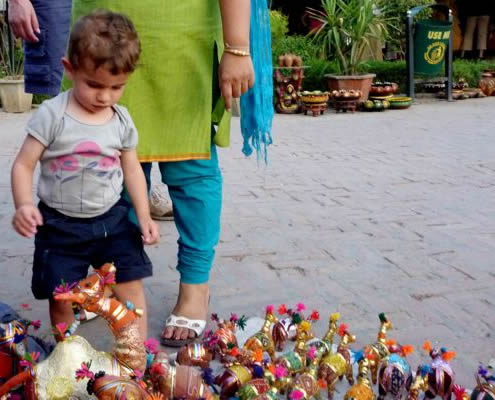
We bought a nice skirt for me (200 rupees) and a dress for a friend’s daughter; some funny soy-based snack food (a Cheez-Doodle look-alike, sans cheese) called namkeen that Marcus loved and just kept eating; a beaded strand of hand-made elephants (150 rupees) to hang in Marcus’s room; and another nine mangoes, since there were mango growers set up in a special tent celebrating the Kesar Mango Festival. Sadly, we had missed the mango-eating contest by just a couple days, but we got lots of samples and bought six of the most expensive Kesars they had (plus three more Alphonsos). All in all, we really enjoyed ourselves—there was actually incredibly low pressure from the salesmen, especially by Indian standards. It was a great last evening in Delhi. As the evening progressed, the place began to get a little more crowded, with Indian women friends, mother-daughter pairs, and several groups of Westerners.
Back at the hotel, we cut and ate a dozen mangoes between us. We did an unofficial taste test, trying to distinguish between the Kesars and Alphonsos. Robert preferred the Kesars, and I the Alphonsos, but even I had to agree that the Kesars we had in India were really so much better (uh, and cheaper) than the Kesars we get, imported, from Indian grocers in Waltham.
Robert showered, Marcus and I washed up, and all three of us changed into our traveling clothes and left at 9:00 in the hotel car for the airport. Arriving at the airport was another adventure, as of course by now we should have expected it to be. Marcus was asleep in my sling before we got out of the car, and with all our bags on a trolley that the driver had found us, we finally managed to get into the proper Air France line. You had to show your boarding pass and passport before you even entered the physical airport building, so the lines were somewhat long and confusing. There was an altercation between a woman and two of the (heavily armed) guards at the Air France entrance, literally two people in front of us, and I got a little panicky and kept sidling away. You know, standard stuff—the woman was yelling, “Go ahead, call your supervisor! Go ahead!” and even pushing the guard in the chest, and the guard kept laying a hand on his gun and telling her to stand back. Gee, I wonder why I stepped aside.
Inside, we got our boarding passes, checked our bags, and then found the main security lines, which are single-sex. I actually think that’s so much better than, here, waiting on the other side for the TSA to call over a female screener and then having to specially request a private room for a pat-down if you don’t want to be patted down in full view of everyone. Here, Robert and I (holding the still-sleeping Marcus) just went in separate lines, separate doors, and my line was completely female-staffed, with just the screener, a (female) guard, and me in the room for what was an obligatory pat-down for all. The screener asked me a question while she was looking at my passport, and I hadn’t quite understood everything she said, but I smiled and nodded and agreed. I thought she was saying something like, “Did you and your husband have a good trip in India?” or maybe even, “Is your husband in India with you?” so I figured that yes, the answer was obviously yes to both. As I was nodding and agreeing, I suddenly figured out that she’d actually asked, “Is your husband Indian?” and had nodded at Marcus’s tanned skin. “Ah!” I exclaimed. “No, no, he’s not.” She seemed surprised by my about-face.
On the other side of security, we tracked down the first-class lounge. There are two, side-by-side, for the entire Delhi airport, all airlines, and they’re not quite up to the Air India JFK lounge standards. I found a spot on a couch, Marcus still asleep in the sling, and Robert found some chai and some packaged Kurkure Masala Munch snacks, which seemed to be Indian-spiced Cheetos, or perhaps a spicier, mass-produced namkeen. They definitely had a spicy kick to them, and we all loved them, including Marcus (when he woke up). I started talking to an older woman in the lounge who turned out to be the diplomatic envoy from Macedonia, stationed in Delhi, but also covering other countries in Asia, and therefore en route to Hong Kong that night. She had to leave for her flight soon, though, and then we had to leave for ours.
Air France? Not as nice as Air India. We slept almost entirely on this first leg, to Paris, and then changed planes, had to go out of and then back into security (eye roll), and took the final Paris-New York leg. The Air France flight attendants were far less kid-friendly, and kept saying that Marcus wasn’t allowed in the galley at all, even if they were doing nothing but standing there and he just wanted to stand there too and hang out with Robert a little. They were also insistent on the ridiculous European seatbelt-attachment things for lap babies, which Air India and even Alitalia last year hadn’t made us use. Not terribly surprisingly, Marcus screamed and screamed when we tried to restrain him in that for landing. I eventually just left it attached to him, but not to me, and nursed him in my lap, figuring a quiet, content baby was better for everyone’s safety: mine, his, and the flight crew’s. At the Air France first-class lounge in Paris, we mixed all sorts of nice fizzy drinks with juices and sparkling waters; played with another baby who was en route from Mali to Washington, D.C.; tried to use the funny French-layout keyboards to email a message home; and thought about showering but didn’t.
Over the course of our trip, we developed various coping strategies. First, we realized in India that it helps to be a New Yorker—we have a good ability to ignore hawkers, scammers, etc. Then, I decided I would just stare right back at anyone who stared at me—and indeed, that turned out to be nearly everyone. I’m a white woman with a white baby in a funny thing strapped to her body, next to an extra tall white man holding all the bags and acting like a coulee himself. Why wouldn’t people stare? Just stare back. We also realized that train and plane pickups went a very very very long way to making the trip more comfortable for us—in the future, we would do anything to reconfirm these and double-check the pickup details. Finally, I think babywearing and nursing got us through the trip. We generally travel light, and wearing Marcus (and co-sleeping) meant we could do this even more so than a lot of parents who travel. Whenever he needed to sleep, he slept. Whenever he was overwhelmed, he just tucked his head into me. Nursing helped keep him hydrated and offered comfort and something familiar in unfamiliar places—we nursed everywhere, on the plane, on trains, in cars, in tuk-tuks, even on the bike rickshaw, at monuments and ruins and parks and palaces. About two days over the trip breastmilk and a lot of water was all Marcus had to eat—he was hot, his routine was off, and sometimes he’d reject all food we offered, even things we knew he liked, but I always knew he’d be okay. Of course, other days he’d devour the familiar crackers, pretzels, cereal, and applesauce we’d brought along, and then shovel in rice, chow down on coconut chutney, shove papadums into his mouth, and down a mango lassi. It was highly variable, as I think all toddler eating is, but knowing he was getting comfort, hydration, and good nutrition no matter what really helped. As far as the babywearing, well, I don’t know how else we would have managed train stations, stairs, bags, and crowds. It also made seeing the sights at the coolest times of day possible, knowing that we didn’t have to go back to the hotel at the first sign of tiredness.
Breakfast became our most important meal of the day—sometimes, the only one. We never skipped a breakfast, but, because of train schedules and exhaustion, occasionally breakfast—and then snacks, fruit, etc.—was the only real meal we had until the next breakfast. So yeah, eat breakfast—because you never know when you might fall asleep and sleep through multiple meals.
One thing that bothered me about this trip is the whole “Why India?” question we got when we told people we were going to India, or had just returned from there. Well, why not? We travel to experience different things and see what life is like in different places. No one would ask, “Why Paris? Why Hawaii?” etc.—it bothers me that somehow we have to justify our choice of destination.
People again always said that traveling with a toddler was hard, and yes, it is hard, but in some ways, the same things that are hard about traveling are the things that are hard when staying home—remembering to shove all the breakables far out of reach when sitting down in a restaurant, for instance, or dealing with typical toddler meltdowns over—at one moment—not wanting to put his shoes on, and at another moment, not wanting to take them off. So yes, some things are difficult, but some things always are, and we work around them and enjoy the many, many benefits of traveling with our son.
In sum, our trip statistics:
- Elephant rides: 1
- Camel (cart) rides: 1
- Dogs, cows, sheep, goats, donkeys, bulls, buffalo in the road, on the sidewalk, or on the train tracks: Innumerable (plus additional elephants and camels, mostly in Jaipur)
- Peacocks: A lot
- Cats: 0
- Nights Marcus and Christina fell asleep mid-afternoon or early-evening and slept through dinner until early morning: 4
- Nights Robert got more than five hours of unbroken sleep and/or woke up well-rested after whatever sleep he did have: 0
- Days of fun spending every minute together as a family in exciting new places: 14